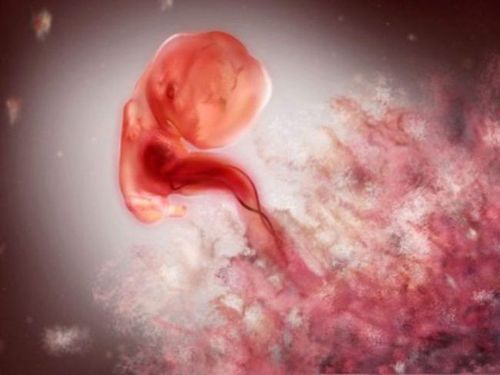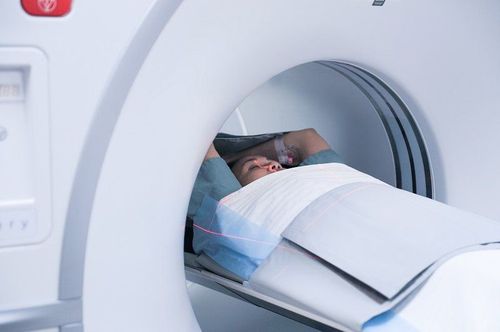This is an automatically translated article.
Cerebral artery malformations are congenital abnormalities of blood vessels in the brain. This condition occurs due to the abnormal development of the vascular system that causes blood to flow rapidly and go directly from the arteries to the veins, bypassing the surrounding tissues. If the disease is not detected early and treated promptly, it will cause serious complications such as: brain hemorrhage, brain damage, heart failure and blood swelling.
1. Cerebral artery malformation
Cerebral artery malformation is a tangle of abnormal blood vessels that connect arteries and veins in the brain. The arteries are responsible for taking oxygen-rich blood from the heart to the brain. Veins carry oxygen-depleted blood back to the lungs and heart, and with a cerebral arteriovenous malformation this process is disrupted.
Arterial malformation can develop anywhere in the body but it most often occurs in the brain or spine. Despite this, cerebral arteriovenous malformation is rare and affects less than 1% of the population.

Dị dạng động mạch có thể xảy ra ở cột sống
2. Causes of cerebral artery malformation
Currently, the cause of cerebral arteriovenous malformations is still unknown, but researchers believe that most cerebral arteriovenous malformations usually appear during the formation and development of the fetus.
Normally, the heart will do the job of bringing oxygen-rich blood to the brain through the arteries. Arteries slow blood flow by passing through a series of networks of blood vessels that get smaller and end up being the smallest blood vessels (capillaries). The capillaries slowly carry oxygen through their thin, spongy walls to the surrounding brain tissue. The hypoxic blood then enters the small blood vessels and then to the larger veins that suck blood from the brain and return the blood back to the heart and lungs for more oxygen.
Arteries and veins in cerebral arteriovenous malformations will lack the support network of smaller blood vessels and capillaries. Instead, there is an abnormal connection that causes blood to flow quickly and go directly from the artery to the vein, bypassing the surrounding tissue.
Anyone can be born with cerebral artery disease. Some risk factors for the disease include:
Gender: Men are more common in men than women. Medical history: Cases of cerebral arteriovenous malformation in families have been reported, but it is not clear whether it is hereditary or whether the occurrences are purely coincidental. Or it can also be due to inherited other factors that also cause cerebrovascular malformations.

Dị dạng động mạch não có thể xảy ra trong quá trình hình thành và phát triển của thai nhi.
3. Symptoms of cerebral artery malformation
Cerebral artery malformations may not cause any signs or symptoms until a cerebral artery ruptures, resulting in bleeding in the brain (hemorrhage). In about 1 in 2 people with cerebral arteriovenous malformation, the first sign to appear is bleeding. However, for some people, in addition to bleeding, there are other signs and symptoms. These are:
Convulsions Headache or pain somewhere around the head Muscle weakness or numbness in certain parts of the body Neurological signs and symptoms. This symptom can range from mild to severe and it depends on the location of the cerebral artery malformation. It can be: Severe headache, weakness or paralysis, loss of vision, trouble with it, confusion... Symptoms can begin at any age but usually appear between the ages of 10 and 40. Cerebral artery malformations can damage brain tissue over time. The effects slowly build up and will cause symptoms in early adulthood. However, by middle age, cerebral arteriovenous malformations tend to remain stable and cause few symptoms. In pregnant women with this condition, symptoms may worsen due to changes in blood volume and blood pressure.
Severe cerebral arteriovenous malformation is usually a defective vein of Galen, causing signs such as swollen and visible veins on the scalp, seizures, congestive heart failure.

Nhức đầu là triệu chứng phổ biến
4. Diagnosis of cerebral artery malformation
To diagnose cerebral arteriovenous malformations, neurologists usually review the symptoms and conduct a physical examination. In certain cases, your doctor may order one or more tests to make a diagnosis. Some of these tests are:
Cerebral angiogram: This is the most detailed test to diagnose brain artery malformations. The test results will show the location and characteristics of the arteries supplying and draining the veins. This is extremely important for treatment planning. CT scan: Uses X-rays to create detailed cross-sectional images of the brain. For specific patients, a dye can be injected intravenously so that the arteries feeding the cerebral artery malformation and the draining veins can show more detail. MRI scan: This method combines the use of magnets and radio waves to create detailed images of the brain. The results of an MRI scan provide information about the exact location of the malformation and any bleeding associated with the brain.
5. Treatment of cerebral arteriovenous malformations
Cerebral artery malformations have several treatment options and the main aim of treatment is to prevent bleeding. However, treatment to control seizures or neurological complications may also be considered. The specialist will determine the most appropriate treatment in each case and it depends on your age, health, size and location of the abnormal blood vessel.
Some treatments:
Medicine: Medicines can be used to treat symptoms caused by brain artery malformations such as headaches, seizures. Surgery: This is the most common treatment for cerebral arteriovenous malformations. There are three different surgical options for treatment: surgical resection, endovascular embolization, and SRS surgery. Researchers are now looking to better predict the risk of bleeding in people with cerebral arteriovenous malformations, thereby better guiding treatment. They will use 3D imaging technology to map the brain line to improve the accuracy and safety of surgery in the process of removing cerebral artery malformation while preserving surrounding vessels. Combined with advances in embolization, radiotherapy, and microsurgery, inoperable anterior cerebral artery malformations are easily accessible and safe for surgical resection.

Phẫu thuật là một trong những phương pháp điều trị bệnh
6. Complications of cerebrovascular malformations
Cerebral artery malformations often cause complications such as:
Bleeding in the brain (hemorrhage): Cerebral artery malformations put extreme pressure on the walls of the arteries and veins, causing them to become thin or feebleness. This can lead to rupture of a cerebral artery and bleeding into the brain. The bleeding risk of cerebral arteriovenous malformations is estimated at 2% per year. The risk of bleeding may be higher for some types of cerebral arteriovenous malformations or it may be that the patient has experienced previous cerebral artery ruptures.
Cerebral artery malformations account for about 2% of all hemorrhagic strokes each year and are often the cause of bleeding in children and adolescents who have had a cerebral hemorrhage.
Decreased oxygen to brain tissue: Cerebral artery malformation occurs when blood bypasses the capillary network and flows directly from the artery to the vein. The surrounding brain tissue cannot absorb oxygen from the rapidly flowing blood. The lack of oxygen causes brain tissue to weaken or even die completely. This leads to stroke-like symptoms, difficulty speaking, numbness, loss of vision... Thin or weak blood vessels: Cerebral artery malformations put pressure on the vessel walls causing them to thin and thin. feebleness. When there is a bulge in the wall of a blood vessel (aneurysm) it can be very easy to rupture. Brain damage: As the body grows, the body needs more arteries to supply blood. But some arteries can become larger or displace or compress the rest of the brain, preventing the protective fluid from flowing freely around the hemispheres of the brain. When this fluid accumulates, it can push on brain tissue causing hydrocephalus. Cerebral artery malformation is a dangerous disease that needs to be diagnosed and treated promptly, otherwise it will seriously affect the patient's health.
Vinmec International General Hospital is the address for examination, diagnosis and treatment of diseases, including specialized neurological examination, internal medicine, etc. With the advantage of having specialized doctors with many years of working experience. and experience in treating difficult cases, complex surgery will give the best treatment plan for customers.
You can directly go to Vinmec Health system nationwide to visit or contact the regional hospital hotline here for support.
Reference source: mayoclinic.org
See also:
Treatment of cerebral hemorrhage due to rupture of cerebral vascular malformations Methods of diagnosing cerebral vascular malformations Cerebral vascular malformations: Causes, symptoms, diagnosis and treatment













